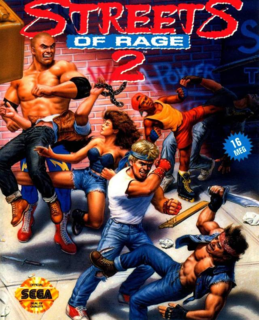If you consider yourself a fighting game aficionado & haven't played SoR II, you need to rethink your life.
SoR II is one of those few titles that you can dedust and blast through multiple times on an annual basis and still be astonished by just how much fun it actually is, even with the ever-increasing polygon counts and cinematic cutscenes courtesy of technology's current state.
Before you start providing foes with tickets to infirmary, you'll get to choose from four characters. They vary in attributes of power, technique, speed, jump and stamina. It can be said that Axel and Blaze seem to be more of an allround brawler, while Max and Skate (seriously, who decided to rename him "Skate" for US/European releases?!) tend to have specific strengths and weaknesses.
Few minutes into the game you might notice that visually it has a certain punk vibe to it. Not only do your alter egos try their best to look like your mother-in-law's nightmare, but your opponents take it up a few notches looking like complete scumbags that just returned from a Sex Pistols gig.
If you prefer your games linear, like most titles of that era happened to be, SoR II is definitely for you. There are no alternate paths or story bits told throughout the stages. You'll find none of that modern "nonsense" in this game. What you'll get is a take-no-prisoners approach to the side-scrolling fighting formula that lives through its great gameplay. All you need to do is pass the levels from left to right and take out the several enemy types and bosses thrown at you. Also, multiple environment objects can be found and smashed to reveal items such as life-ups, coins or weapons. Additionally you can knock out antagonists to steal their arms (knives, pipes etc.).
The control scheme consists of a simple three-button layout. B is used for a combination of punches and kicks, C is for jumps and A will trigger a more powerful special move, which comes in handy for boss encounters, but depletes a bit of your life gauge. You can also execute a dropkick maneuver while jumping. It might probably set male players to mourn that Blaze's upskirt sprite animation was banned from the US release...
To compensate for its somewhat limited gameplay mechanics, SoR II offers some of the whackiest bosses of the fighting genre. When you encounter a silly looking dude that goes by the name of "Jet" at the end of stage two, who actually lives up to his name by wearing a jetpack and white overall, you know that the boss designers are pretty far out there. It's also funny to see a homage to the Walt Disney castle in the backdrop of stage three, which appears to be an amusement park. Still, those spankers have nothing better to do than relaxing on benches and taking a break from the thug's life until you approach them. The subtle humour is also an integral part of what sets SoR II apart from many of its competitors.
SoR II has eight distinctive, well crafted stages in total, each lasting about 10-15 minutes.
Given the fact that there's only a limited amount of continues, it really ain't a walk in the park, unless, of course, you set the difficulty to easy. Still, the difficulty is nowhere near as brutal as in the crippled western versions of SoR III.
SEGAs acclaimed brawler looks damn good for a game released almost two decades ago. It got out in 1992, so it must've been state of the art back then. The main characters' sprites are beautifully modelled, even if they could use an extra animation frame here and there. Overall the visuals have a little Anime touch, so if you're into that stuff, you'll like it. There are a few slow downs every now and then, when things get busy on screen, but it's barely an issue.
Oh and the sound. My, the sound... It's amazing to hear what a machine from the late 80s is capable of. Yuzo Koshiro must've taken the last byte he could get out of the Yamaha chip to turn it into a stunning worship of early 90s electronic music. It's just MIDI, but rarely gets old. In fact it could possibly produce a few Lounge/Club hit singles if the arrangements were transferred to real instrumentation.
Even if you're just remotely interested in fighting games, you owe yourself a favour to pick up SoR II. Its simple yet addicting gameplay has withstood the test of time and the visuals still work for what it is. SoR II got plenty of style and the subtle humour, hilarious bosses and flawless controls make it the king of 16-bit side-scrolling beat 'em ups (along Final Fight 2, that is).
Get it for Genesis if you're a collector or download it for the Wii VC at 800 points. It's worth every point.
But on a final note, try to refrain from purchasing SoR III unless you got II and I already, as the US and PAL versions were altered significantly (changes to storyline, missing mini-boss character, female outfits got censored, difficulty increased to the verge of ridiculousness etc.).
Graphics: 7/10
Sound: 9.5/10
Gameplay: 8.5/10
Lifespan: 8/10
Overall: 8.5

